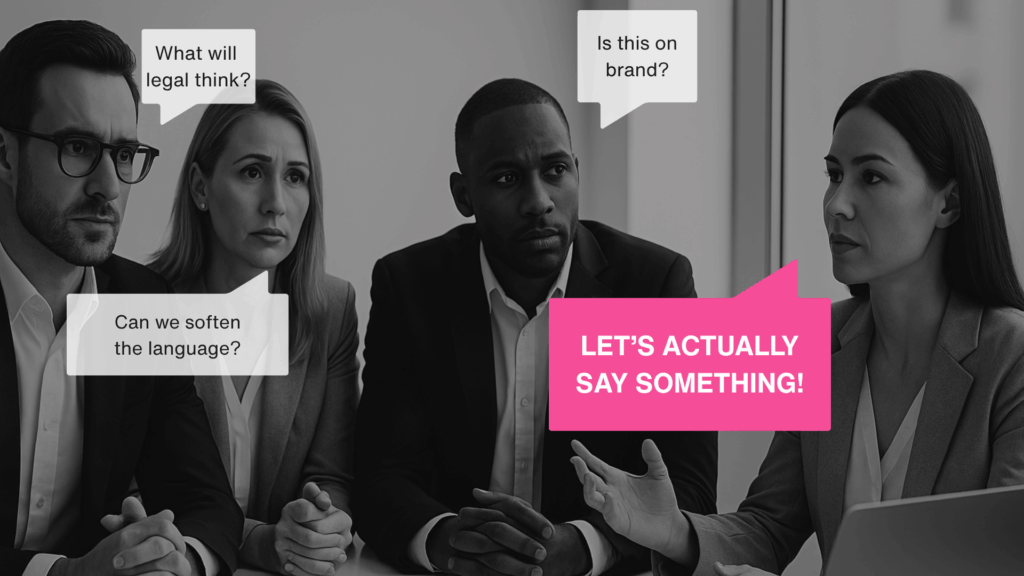
Most B2B content isn’t bad. It’s just afraid…of offending, of standing out, of actually saying something. And that fear is costing you attention, authority, and pipeline.
“Let Me Guess How This Got Made…”
You started with a real insight. Maybe a pain point pulled from a customer convo. Maybe a bold POV that had your team nodding.
Then came the internal feedback:
- “Can we make this more on-brand?” (Translation: Remove the edge.)
- “What will Legal think?” (Translation: Let’s remove anything that might cause a feeling.)
- “Does this align with our Q2 theme?” (Translation: Let’s shoehorn this into something else entirely.)
So now what could’ve been a sharp, ownable take is another templated blog post with four subheadings, three stats, and a soft landing.
You didn’t write boring content. You wrote safe content.
The Real Risk Isn’t Boldness — It’s Being Ignored
No B2B buyer is reading your content for fun. They’re scanning. Deciding whether you understand them. Whether you’ve solved this problem before. Whether your brand has a pulse.
Safe content doesn’t do that.
Safe content tries to be everything to everyone — and becomes nothing to anyone. It’s optimized for approval, not impact.
The Vicious Approval Loop
Here’s the dirty truth: the more people that have to approve your content, the worse it gets.
- Sales wants more product plugs.
- Product wants precision over clarity.
- Brand wants tone police duty.
- Leadership wants to “sound credible.”
Each round of edits smooths it out. Pulls it toward the middle. Until it’s perfectly inoffensive — and completely ineffective.
No clear enemy. No original POV. Just another B2B blog trying not to get in trouble.
You Need a POV Before You Need a Calendar
This is the part nobody wants to say: your content calendar isn’t the problem. Your lack of strategic backbone is.
If you don’t know:
- Who you’re really for
- What tension you’re leaning into
- What you refuse to sound like
…then you’re just producing. Not positioning. Not building belief. Just feeding the machine.
And the machine doesn’t care whether it performs. It just wants to be fed.
Safe Brands Don’t Get Shared
People don’t share content because it’s well-structured. They share it because it hits.
Because it said the quiet part out loud. Because it finally put words to something they’ve been thinking. Because it had a take.
You don’t need to be loud or edgy. But you do need to be distinct. Clear. Human.
If your content could’ve been written by ChatGPT with a LinkedIn filter — that’s not a win.
This Is What Thought Leadership Actually Is
Clients say they want to become thought leaders. And they assume that means writing a certain kind of content — polished, authoritative, maybe even a little safe.
But real thought leadership isn’t a style. It’s not a tone. It’s an approach.
Your company’s probably been in business for years. You’ve got people who’ve been in this industry for decades. That’s a goldmine. Thought leadership is simply putting your earned secrets, your battle scars, your hard-won perspective on paper.
The best thought leadership is transparent. It’s honest. Sometimes, it’s counter-narrative. It’s not “content” — it’s experience, delivered with guts.
But here’s the problem: the approval loop kills thought leadership. The exact voices that have the sharpest takes get drowned in layers of revision and fear of saying too much. That’s not content strategy. That’s brand damage.
What Bold Looks Like (And Why It Works)
Bold content doesn’t just say “look at us.” It says, “We know exactly what you’re dealing with — and we’re not afraid to call it out.”
Safe:
“Today’s media landscape is evolving faster than ever…”
Bold:
“Your distribution is broken — and your team is too busy to fix it.”
Safe:
“Content is key to driving engagement and building brand loyalty.”
Bold:
“If your content reads like a case study written by Legal, don’t act surprised when nobody clicks.”
See the difference? One keeps the peace. The other earns attention.
Want Better Content? Start with a Backbone.
Here’s what strong content teams do differently:
- They anchor in a sharp brand POV.
- They pick a sid. In every piece.
- They push back on “just publish it” culture.
- They don’t ask for permission to be interesting.
Not every piece has to be controversial. But every piece should be clear, specific, and unmistakably you.
Because in today’s content economy, safe = invisible.Tired of writing content that checks the boxes but changes nothing? Let’s build a brand with something real to say — and the guts to say it.